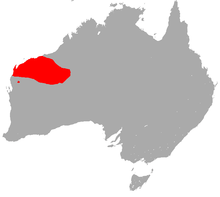Little red kaluta
The little red kaluta, or simply kaluta, (Dasykaluta rosamondae), is a species of carnivorous nocturnal marsupial. It lives in the arid regions of northwest Australia. Individuals are around 100 millimetres long and weigh from 20 to 40 grams. They live for about three years in captivity.
| Little red kaluta | |
|---|---|
| Scientific classification | |
| Kingdom: | Animalia |
| Phylum: | Chordata |
| Class: | Mammalia |
| Infraclass: | Marsupialia |
| Order: | Dasyuromorphia |
| Family: | Dasyuridae |
| Subfamily: | Dasyurinae |
| Tribe: | Dasyurini |
| Genus: | Dasykaluta Archer, 1982 |
| Species: | D. rosamondae |
| Binomial name | |
| Dasykaluta rosamondae (Ride, 1964) | |
 | |
| Little Red Kaluta range | |
Taxonomy
Dasykaluta rosamondae is a member of the family Dasyuridae. When it was first described by W.D.L. Ride in 1964,[2] the species was placed in the genus Antechinus. However, in 1982 Mike Archer erected the genus Dasykaluta and assigned it as the sole species.[3] It has since been shown to be most closely related to Parantechinus apicalis, the dibbler.[4]
"Kaluta" is an Aboriginal name adopted from the Nyamal language for this species, and this is reflected in the generic name Dasykaluta, which means "hairy kaluta". The species name, rosamondae, is a reference to Rosamund Clifford, the famous mistress of Henry II of England, who is said to have had red hair.[5]
The common names include little red antechinus, russet antechinus and spinifex antechinus.[6]
Description
The kaluta is a rufous brown colour with fairly coarse fur. In body shape, it is generally similar to the antechinuses, although it has a shorter head and ears. It is also somewhat smaller than these animals.[5] The species is small and robust in form, with a shaggy appearance to the uniformly russet-brown or coppery colour at the upper parts of the body; the underparts are a paler shade of the colour above. The head and body measurement is 90 to 105 millimetres. Ears are short and covered in fur, a little higher than the top of the head and 11–13 mm in length; the tip of the short snout is closer to the eyes than the ears. Their tail is relatively thick and short, from 55 to 75 mm, sometimes swollen toward the base and tapers to a length not greater than two-thirds of the body length. Kaluta has hind feet that measure 15–18 mm long and covered in fur.[6]
The little red kaluta feeds on insects and small vertebrates. A notable habit is flicking its tail in the air as it investigates its habitat.[5]
Male little red kalutas, like several other dasyurid species, die shortly after the September breeding season, probably due to stress. The young are born after a pregnancy of around seven weeks, and are weaned when around four months old.[5]
Habitat and behaviour
The little red kaluta is moderately common in the Pilbara, the west of the Little Sandy Desert and parts of the Carnarvon Basin in Western Australia. The distribution range is restricted to this subtropical environment, where they inhabit hummocks of Triodia, the dominant vegetation of spinifex grasslands. Kaluta live and forage on the sandy soil of the region, searching for invertebrate prey amongst the dense and tough mounds of spinifex.[6]
References
- Burbidge, A. (2008). "Dasykaluta rosamondae". IUCN Red List of Threatened Species. 2008. Retrieved 28 December 2008.CS1 maint: ref=harv (link)
- Ride, W.D.L. 1964. Antechinus rosamondae, a new species of dasyurid marsupial from the Pilbara district of Western Australia; with remarks on the classification of Antechinus. Western Australian Naturalist 9: 58-65 [58].
- Dasykaluta rosamondae (Ride, 1964). — Archer, M. 1982. Review of the dasyurid (Marsupialia) fossil record, integration of data bearing on phylogenetic interpretation, and suprageneric classification. pp. 397-443 in Archer, M. (ed.). Carnivorous Marsupials. Sydney : Royal Zoological Society of New South Wales Vol. 2 i-iv, 407 pp.
- Groves, C. P. (2005). Wilson, D. E.; Reeder, D. M. (eds.). Mammal Species of the World: A Taxonomic and Geographic Reference (3rd ed.). Baltimore: Johns Hopkins University Press. p. 24. ISBN 0-801-88221-4. OCLC 62265494.
- Woolley, P.A. (1995). "Little Red Kaluta". In Strahan, Ronald (ed.). The Mammals of Australia. Reed Books. pp. 57–58. ISBN 0-7301-0484-2.
- Menkhorst, P.W.; Knight, F. (2011). A field guide to the mammals of Australia (3rd ed.). Melbourne: Oxford University Press. p. 60. ISBN 9780195573954.
